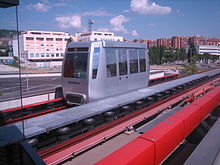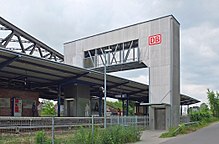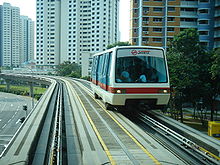People mover
The collective term inherited from the English People Mover (literally "Leutebeweger") refers generally seemed bound and automatically circulating normally transport for short distances, as they are mainly used in airports and fairs. Sometimes the abbreviation PTS for “ Passenger Transport System ” is used instead of the term People Mover .
In some cases , moving walks ( moving walkways , moving sidewalks), passenger elevators or trains in amusement parks are also counted among the people movers. The trains running at high clock sequence cabins or trains are used on routes with high passenger volumes, which is too long and moving walks for rail transport systems are briefly, and depending on the technique of transition to urban or tram can be fluent.
The first people mover is often considered to be the Expo-Express, built for the 1967 World's Fair , which connected the 5.7 km long route from Montreal to the exhibition center with fully automatic trains based on the Toronto subway. The plant was initially shut down after a few years and then demolished. In general, from the 1960s onwards, there were various ideas for often futuristic-looking short-haul transport, including a German draft for the cabin taxi , which was to automatically transport passengers to the desired destination via a branched network at the Hamburg-Kaltenkirchen airport planned at the time . Such railways, which are limited by their individual character to smaller cabins with fewer than twelve occupants, are then referred to as Personal Rapid Transit . A larger, driverless and networked metro system, such as the Dubai metro, for example, is no longer part of the people mover category , but the supplementary feeder system to this metro, the Dubai Monorail .
Most famous designs
Cable car or gondola lifts

With the Cable Liner from the Doppelmayr / Garaventa Group , one or two vehicles traveling on rails are permanently coupled to a pull rope that runs in a loop between the two end stations. With the MiniMetro from Leitner , the vehicles are variably coupled to the circulating pull rope .
The SK system from the French company Soulé, in which the gondolas are coupled to pulling ropes at different speeds, is basically suitable for complex routes, but is significantly more prone to failure.
A special feature is the Skymetro at Zurich Airport , which connects Dock E on the apron with the main terminal, and the Serfaus underground Dorfbahn . They are pulled by a rope, but float on an air cushion over a smooth concrete floor in a tunnel.
Also cable-drawn subways are the Tünel in Istanbul (Turkey), built in 1875 , the Füniküler Kabataş – Taksim, opened in 2006 as the second cable-drawn subway in Istanbul, and the Karmelit subway in the urban area of Haifa (Israel).
Monorails
Many people movers are often mistakenly referred to as a monorail or monorail to distinguish them from the subway or railroad, even though they mostly run on multiple rails or concrete lanes. However, some monorails can be counted among the people movers.
Overhead conveyors
For the SIPEM ( Siemens PEople Mover) system, the H-Bahn at Dortmund University and the SkyTrain at Düsseldorf Airport are well-known examples of typical people movers.
Rubber-tired railcars with concrete driveways
Trains or individual wagons are used at many airports, which run on rubber tires like buses, but are guided by a rail in the middle of the lane and supplied with electricity. Known example is the Leitschienenbahn SkyLine the manufacturer Bombardier at Frankfurt airport ; Similar systems from Bombardier are in use in London Gatwick, Stansted, Heathrow, Rome, Madrid, Miami Airport, Miami Downtown , Munich Airport , Pittsburgh, Tampa, Orlando, Dallas, Denver, Las Vegas, Atlanta, San Francisco and Seattle. These systems are also known as Automated Guideway Transit (AGT) because of the guide rail, which in older models often protrudes as a beam profile, but is attached below the level of the driveways in modern versions . However, the term AGT is sometimes also used generally for fully automatic rail vehicles in order to distinguish them from conventional subway trains with a driver. This is practiced in Nuremberg with the RUBIN project .
Rail cars with rubber tires or steel wheels
The Véhicule automatique léger (VAL) vehicle developed by Matra was originally developed as an automatic metro , but is used at Paris airports as a people mover ( Orlyval , CDGVAL ) between the terminals. It runs with rubber tires on special rails, a version on conventional rails would also be possible.
The Detroit People Mover has been in use in Detroit since 1987 . It drives fully automated with steel wheels on an elevated ring route through the center of Detroit. The round trip takes about 15 minutes, with stops at 13 stations.
Others
- Schmid people mover

The people mover from the Sonnenbühl-based company Schmid-Maschinenbau is a system that brings four to eight people, as well as wheelchairs and prams, in a cabin across an otherwise difficult-to-negotiate traffic route within 30 seconds . The car is first transported upwards like an elevator in a tower , which also serves as a support pillar , and then slides hanging like a trolley under a bridge construction to the other side to the second tower, where it goes down again. The transition from horizontal to vertical happens in a flowing movement. The first such people mover over the federal highway 312 was inaugurated on July 7, 2001 in Pfullingen .
On December 19, 2006, the world's first people mover to cross train tracks was put into operation in Altbach , and another has existed since June 2007 at the Berlin S-Bahn station in Rummelsburg .
Web links
- Dortmund H-Bahn company
- Schmid people mover : planning for Rummelsburg , planning for Altbach
- ThyssenKrupp elevator systems
- Detroit people mover
- Point track
- Overview of "Innovative Transportation Technologies" (English)
See also
- Coaster (passenger transport system)
- Personal Rapid Transit
- Transporter bridge
- List of automatic guided systems
Individual evidence
- ↑ jjev: GEISTESBLITZE: No more red : badische-zeitung.de, Ratgeber, Bildung & Wissen, July 7, 2012 (July 13, 2012)




